Vellum Venom: 2023 Chrysler 300C
Chrysler designer Tom Gale once said in an interview that taller tires were key to the success of the original Chrysler 300. He then inadvertently let the cat out of the bag, going into detail as to how the wildly popular sedan had the presence of a Bentley because “the 300 is deceptively tall, and we disguised that with larger wheel openings and larger tires. But we also raised the beltline so that the roof looked chopped. The cars always looked relatively low even though they were deceptively tall.”
Deceptively tall is right, and the Chrysler 300 is one of many reasons we now have a dying crop of sedans with worse outward visibility and significantly less utility than crossover SUVs. It appears the sins of 2005 are revisited in 2023’s final run of this iconic family sedan, so let’s run the vellum over a 6.4-liter example of the breed.
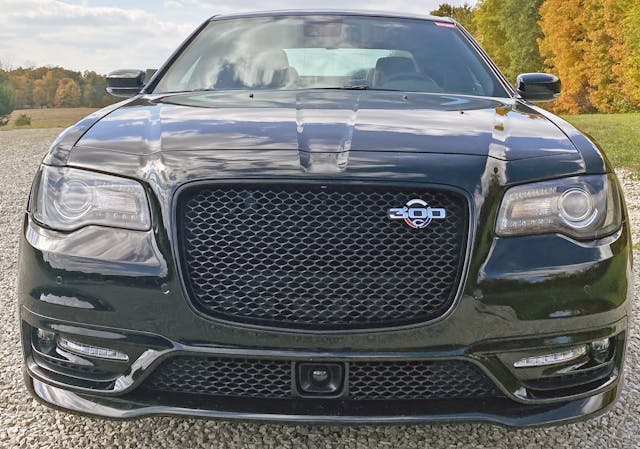
To some extent, the Chrysler 300 lost its trademark swagger once every car sported a nose just as swollen as this. The generic texture of the grille doesn’t help the inability of the 2023 model to stand out in a crowd, either. This honeycomb is in stark contrast to the massive egg-crate texture of the original, which also benefited from the lack of a similarly textured hole below the grille.
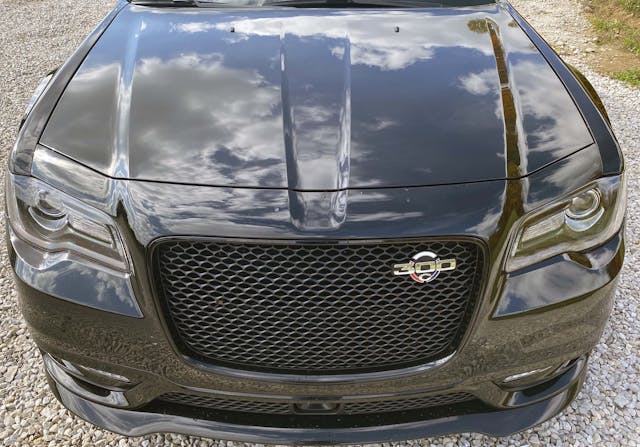
Stand up and behold the 300C from an elevated position and the redesigned fascia of the 2011+ model makes sense. The grille is bold and the headlights are squinty. The front-splitter effect of the bumper draws your eyes up and to the grille, while the reverse mohawk in the hood ensures the space above the grille looks visually lighter.

The retro graphics are a nice throwback to the Chrysler 300 J, but this one is unfortunately tucked away in the upper corner of the grille, unlike yesteryear’s gunsight grille design.
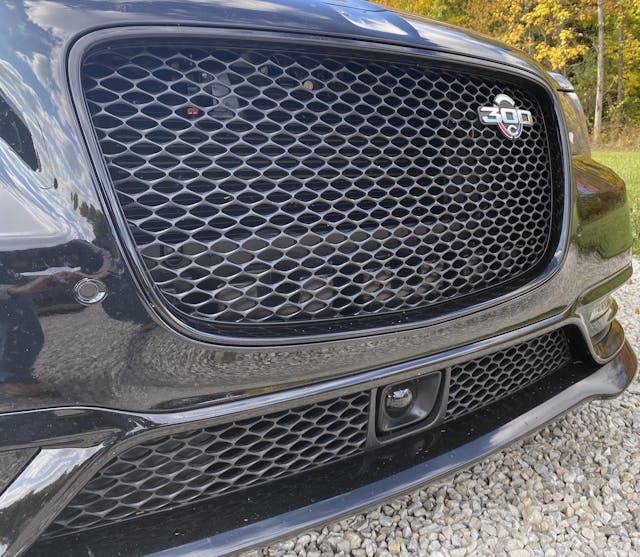
The lack of a bold texture for a Chrysler “letter car” is a bit of a missed opportunity. Much like 1980s American performance cars wearing understated charcoal gray trimmings and Sacco Planks, the 2023 300C might be too understated for its own good.

At least this final example of a bold Chrysler sedan has a grille texture that is never blocked up and eschews artificial texture. The parts that don’t need cooling are blocked off from behind.

And the “seeing eye” of the cruise control sensor is framed by both a thick border of plastic and negative space; designers did not even try to mess with the understated grille texture. Perhaps a design like this would make a great frame for the 300 C logo within a gunsight grille?

The bolder, round fog lights on the flat face of the 2005 Chrysler 300C really helped accentuate the headlights and balance out the radical egg-crate grille. This generic 2010s statement of non-functional performance styling cues on the 2023’s bumper waters down the original vision and leaves a bland aftertaste.

It’s refreshing to see a grille that doesn’t try to incorporate technology like proximity sensors for parking, as their omission keeps the texture from getting murky and complex.
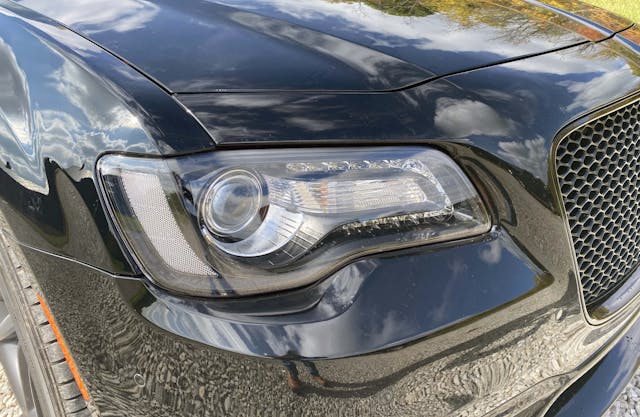
While the 2005 model had design elements (like headlights) conforming to a flat-faced bumper, the redesign has headlights that try to become a more evolved surface. That might sound like a word salad, but bear with me …
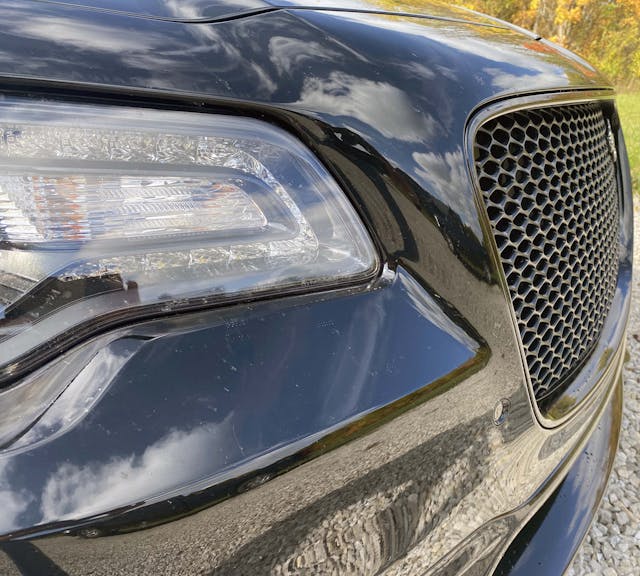
Here on the inner contouring of the headlight, the Chrysler 300’s bumper extends from the headlight to the face of the grille. It’s a refinement that’s light years ahead of the 2005 model, which had a crude stair step in the same location and a bumper shelf that slowed down the visual speed of the front end. The elegant surfacing looks great on this monochrome 300C, but the lack of a shelf hurt other 300s that still had chrome trim where the shelf once lived.
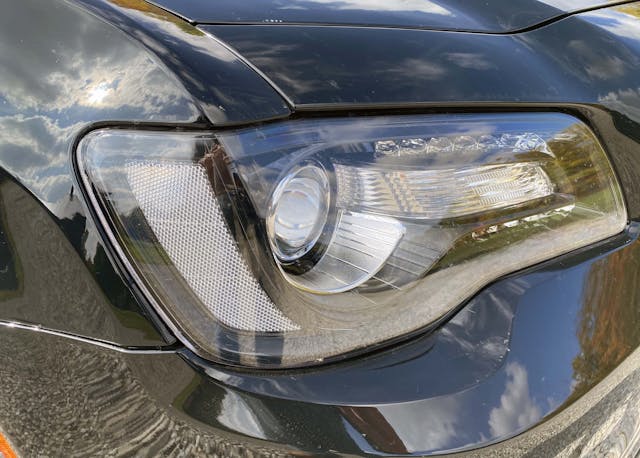
The outer contouring of the headlight is met with sympathetic rounded forms in the bumper. The integral side-mount reflector has a hard contour, which becomes the genesis of a strong fender crease.
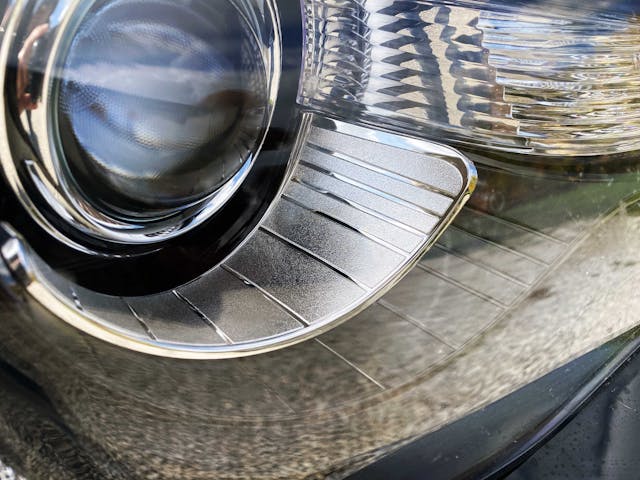
While the subtle transition from the round headlight projector to its chrome bezel is pretty clever, the pattern doesn’t match that of the ribbed turn-signal lights next to it. Another complementary bezel of black plastic that matches the chrome one is clever, but it’s too subtle: the jeweled lights of the 2005 Chrysler 300C, deeply set into the car’s bumper, were more memorable.
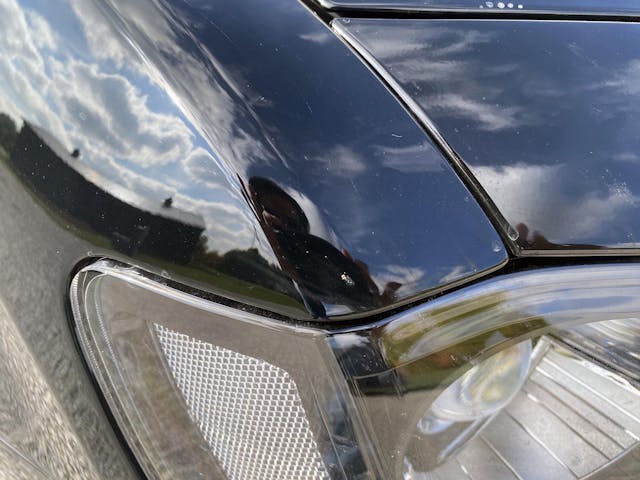
And the panel gap where the fender, headlight, and hood meet is clumsy. This is far less elegant relative to the previous generation Chrysler 300.
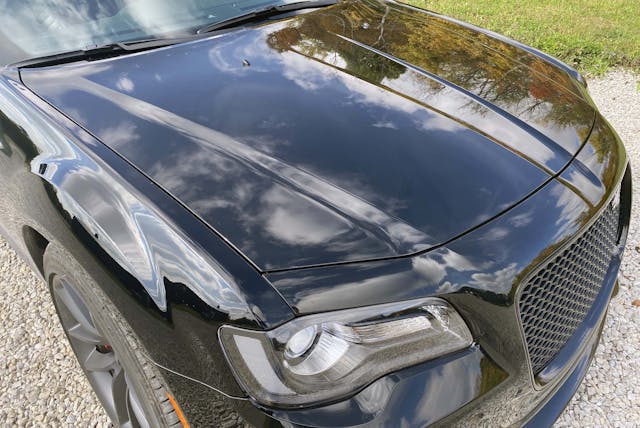
But it is hard to argue with the cool factor present in a fender crease that’s almost as aggressive as that iconic grille design.
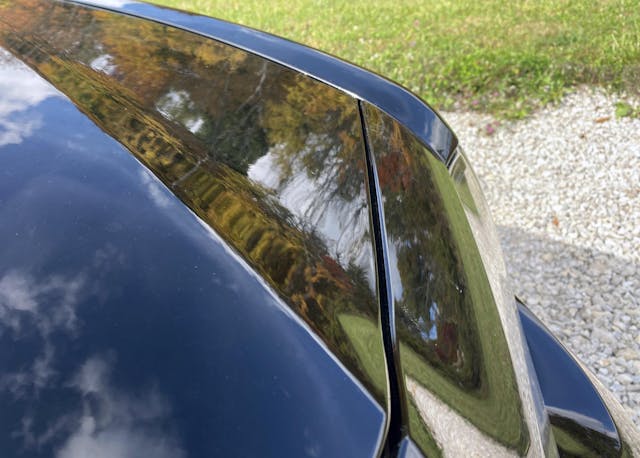
That fender crease does accentuate the strong power bulge in the hood, more so than same feature in the previous generation, with its softer curves.

The one perk to all this extra surfacing over the original is that the current 300 looks far more sinister. And not just the 300C; even a Pentastar V-6–equipped model looks this good. (The same can’t necessarily be said about V-6 versions back in 2005.)

And like most modern vehicles, the 300C has creases that awkwardly disappear into nothing. I reckon it is because vehicles are too tall, too much like rolling billboards: Extending the lines here and there gets your point across. To some extent, this feature would improve the original, 2005 model, as it looked boring and unfinished from many angles.
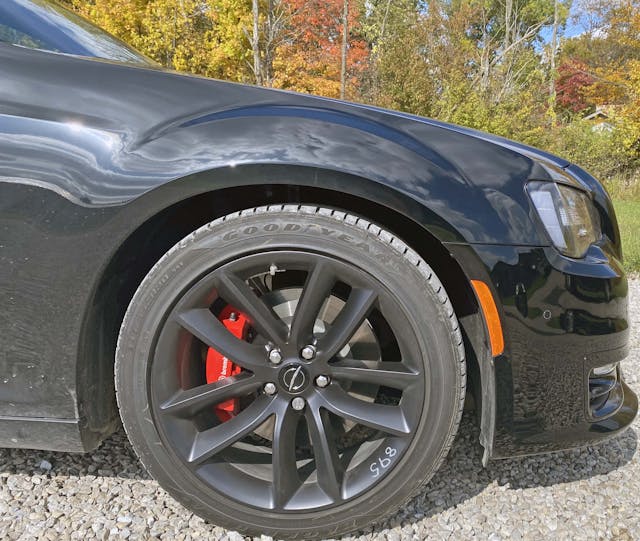
From the side you can see the redesigned 300 has a much smaller face than the outgoing model, but with similarly large fender flares. This makes the 300 look more aggressive than it really is, or just the right amount of aggressive, when you consider the 6.4-liter engine powering this 300C.
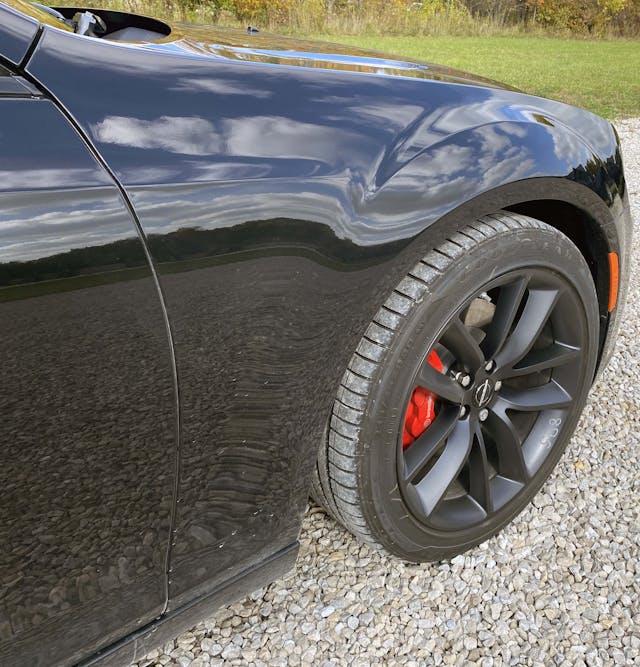
Perhaps that smaller face also accentuates the 300’s long dash-to-axle, which is clearly a million times cooler than that of any other sedan in its class. (Dodge Charger stablemate excluded.)
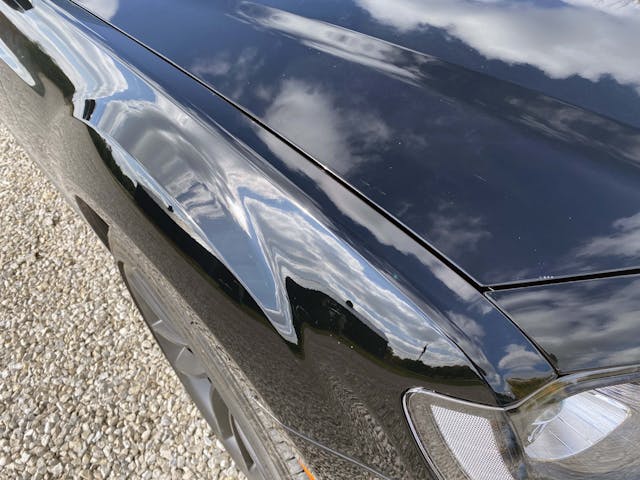
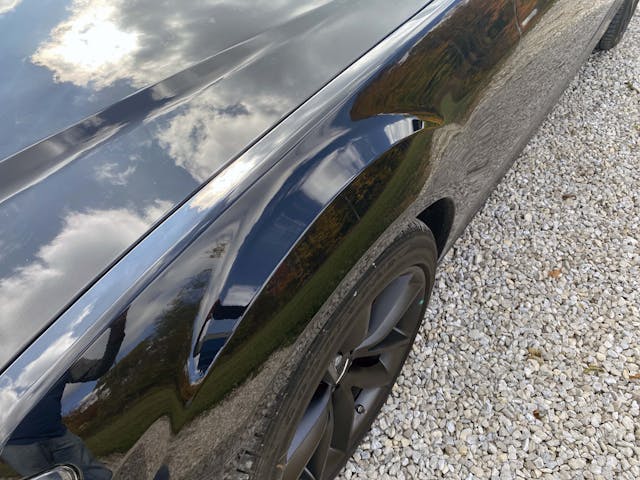
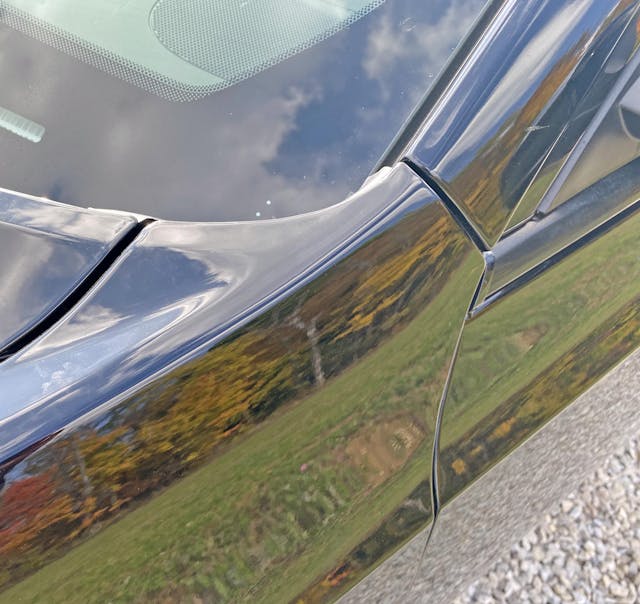
Adding to the decadent dash-to-axle is that long, sweeping fender crease. It goes from the headlight to the base of the A-pillar in one fell swoop.
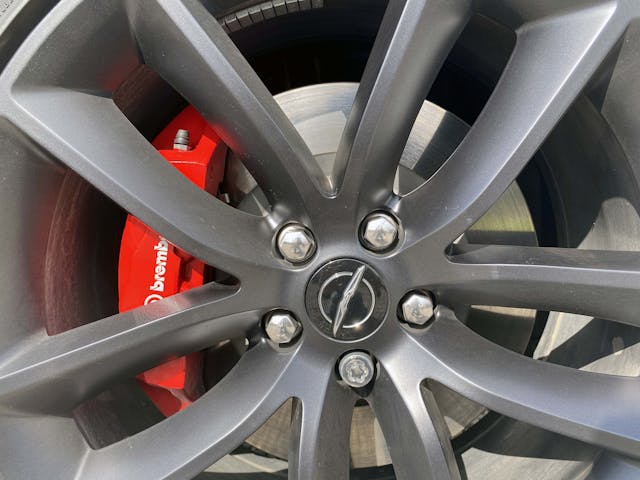
The wheels, while beautiful in their organic simplicity, prove the Chrysler 300 was an entry-level luxury car on its best days and a rental-car special at its worst. These particular forgings have the requisite depth (the hub is sunken relative to the spokes) to be the former, but it isn’t priced like a BMW M3 for ample reason.
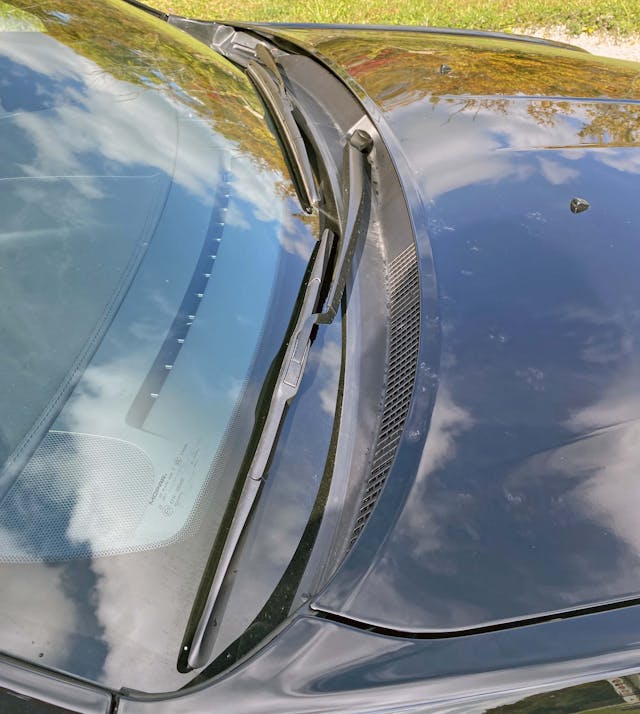
The wiper/cowl area is short and harder to spot at a glance, as you’d expect with a cab backward, long dash-to-axle design. The steep rake from the (higher) hood to the (lower) windshield suggests this area was crafted with pedestrian-friendly design in mind.


The rear-wheel-drive (i.e. long dash-to-axle) proportioning really shines in the 300’s pillars, as that impossibly thin A-pillar belongs to anything but a space-efficient crossover utility. The sideview mirror has assertive angles and a bold repeater indicator light but tucks away perfectly in a black plastic triangle within the DLO.
The front door is almost exaggerated in length, but this car has more of a coupe flavor than its counterparts from Asia and Europe.
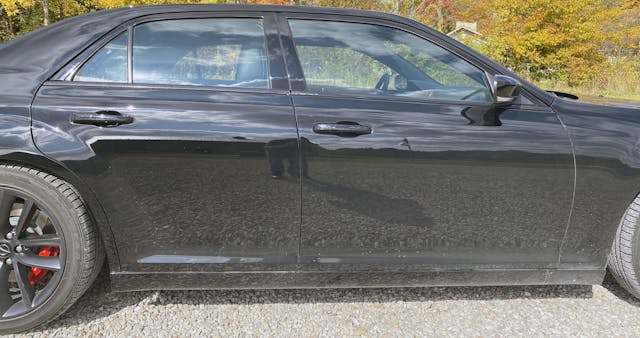
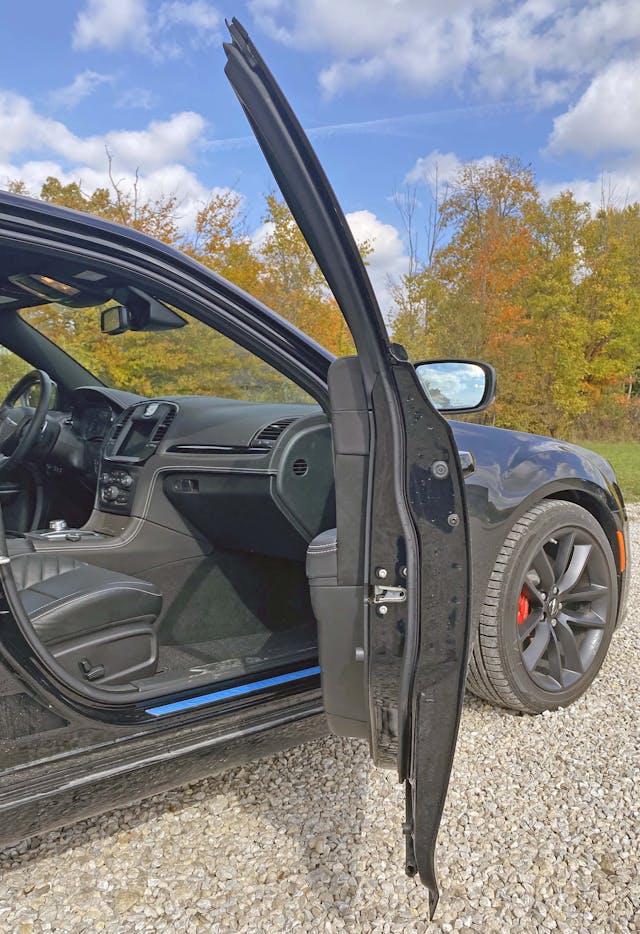
The B-pillar, while static and upright (like all vehicles in this era of head-curtain airbags), has just enough tumblehome to look less like an SUV or CUV, more like a vintage muscle car.
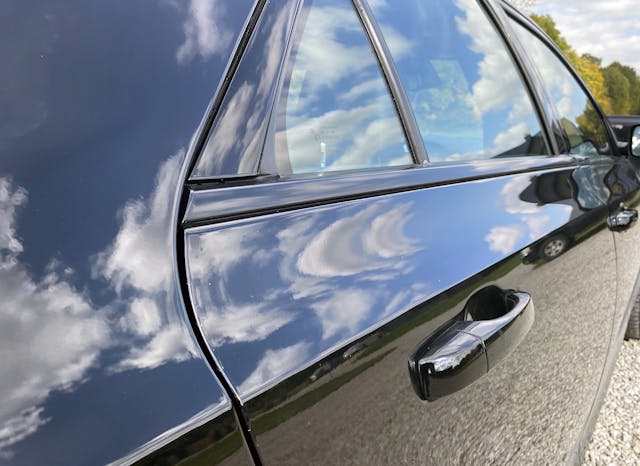
There’s a strong character line a few inches below the DLO, and it’s absolutely needed because the 300 gets even taller in the back (and needs something to break up all that height).
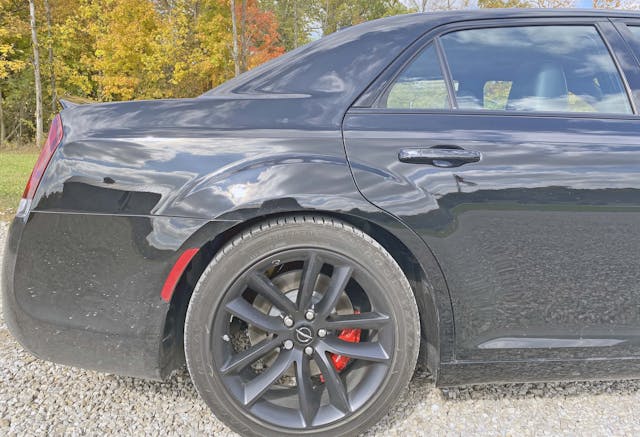
All things considered, Chrysler did a great job keeping the 300 (looking) as trim and low to the ground with its use of horizontal lines and modest surfacing. While not technically a shoulder line, the crease in the C-pillar that turns into the top of the deck lid is absolutely gorgeous and is a nice homage to the 2005 model.
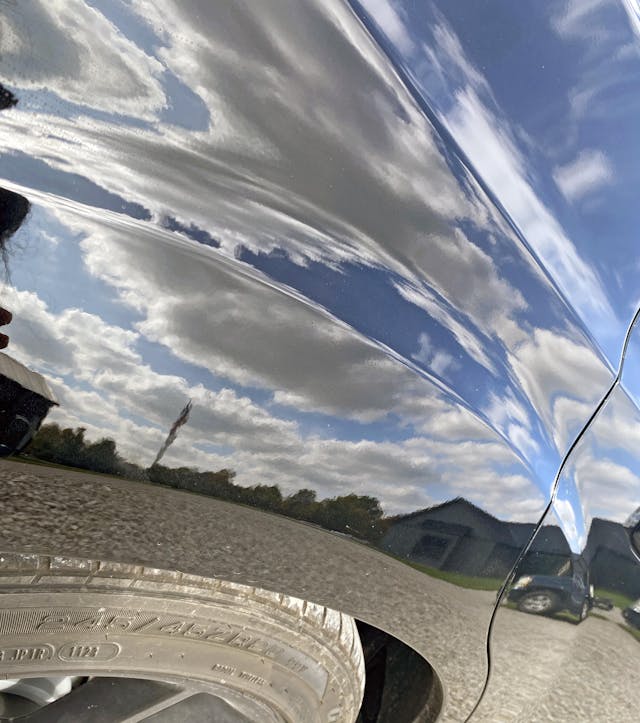
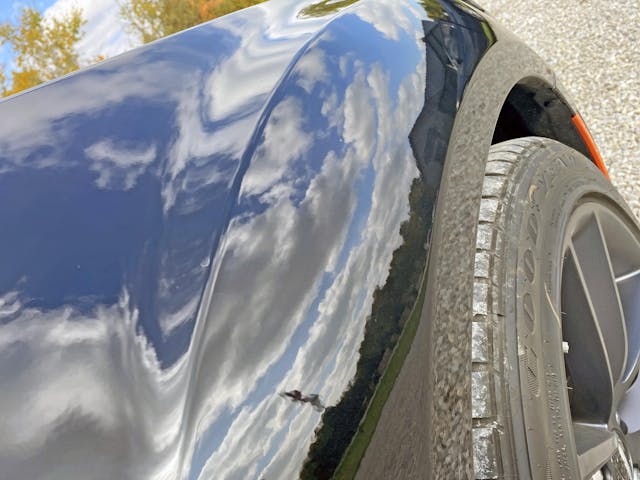
The rear wheel arch is a bit troubling, however. Its thick shape cuts deep into the contours of the rear door, unlike the smooth forms presented in its brother, the Dodge Charger. Perhaps most of the issue is in my head, as I have a particular Avenger haunting my car designer soul.
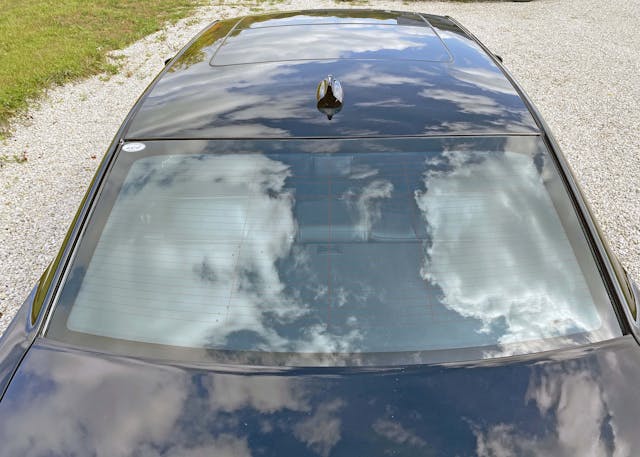
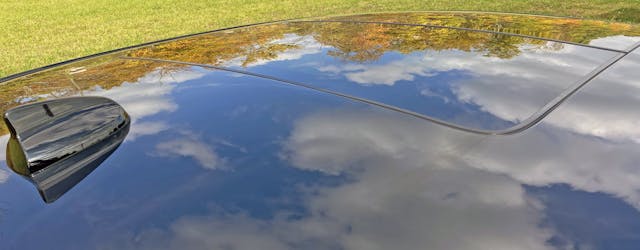
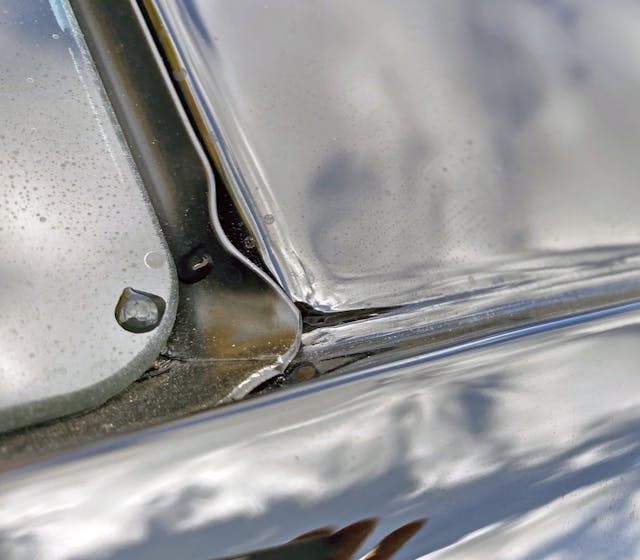
The minimal contouring of the roof (save for cutlines for a fancy moonroof on this 300C) accentuates the long, luxury-sedan lines of the Chrysler and is a good way to save money. The exposed rain gutter isn’t as pretty as the extra plastic strips of other sedans in its class, but I generally prefer its minimalism in a low-visibility area. Can’t give the same kudos for the lasagna noodle–like rear window seal, however.
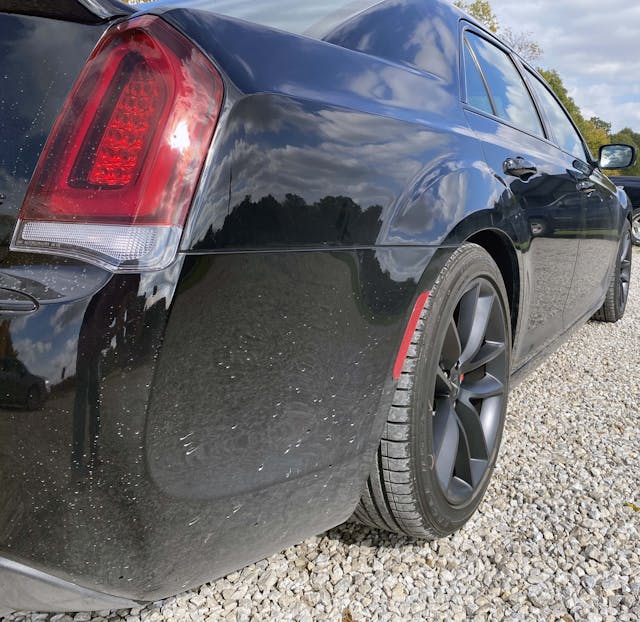
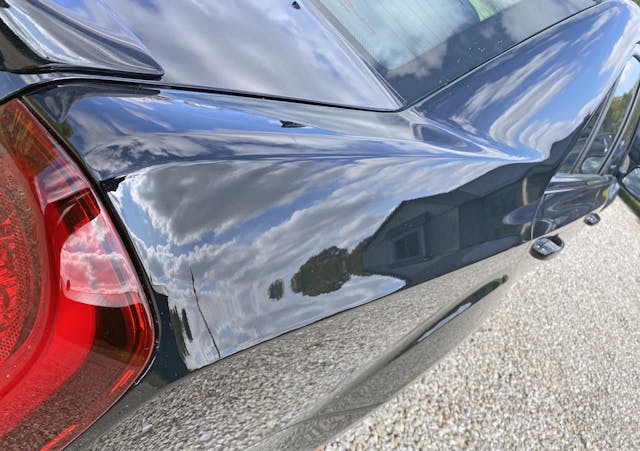
The transition from the aforementioned character line and the shoulder line is harsh and angular, which has implications for the taillight. But it is another throwback to 2005, ensuring the Chrysler 300 has a design DNA like so many other American icons of our past.

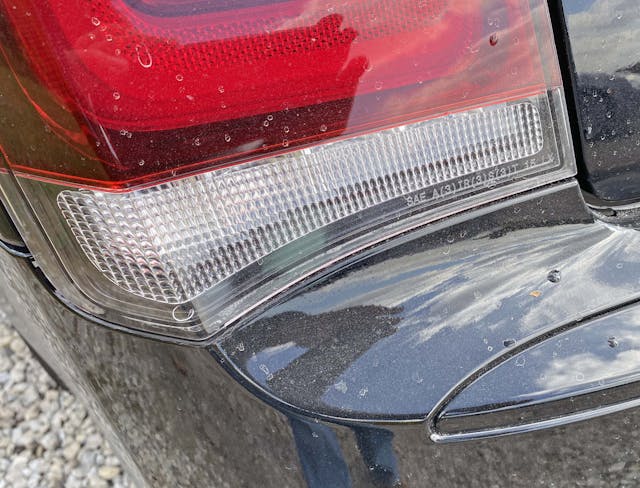
The redesigned 300 eliminates the smiling rear-end treatment created by the original’s curved rear deck and rotund rear bumper. This is produced by implementing the bends in the quarter panel and rear bumper as design limitations of the rear light. The downward force pictured here gives a contrasting frown to the bumper. It’s a little fussy, in a Malaise Era Chevy Monte Carlo way, but eliminates the under-surfaced issue of the previous generation.

There’s a certain harmony that comes from a bumper that’s directly influenced by the outer contouring of the light, and a trunk emblem that naturally steps down from model name to trim level to reverse light.
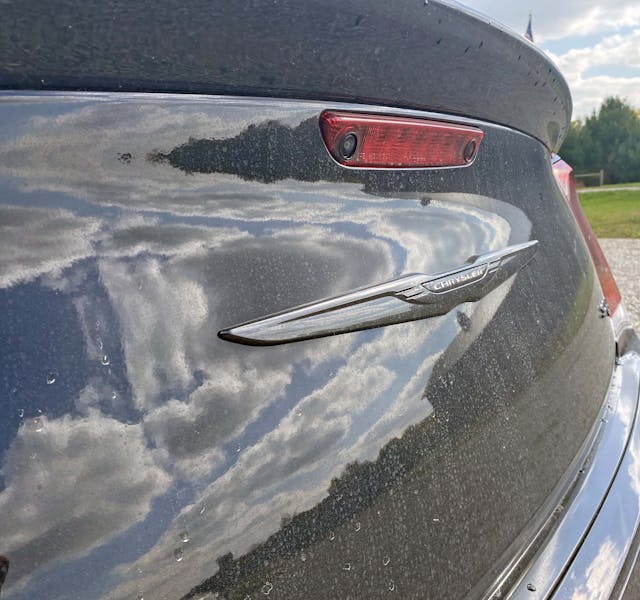
The Aston Martin–like emblem Chrysler chose after its bankruptcy never resonated with me, as there was something special about both the Blue Ribbon and the Pentastar before it. All that recognition was lost forever, so that’s probably why I like it better in a morbid-like black finish on the decklid’s otherwise unadorned center section.

Unadorned is right, because Chrysler did a fine job integrating both a push-button trunk release and a rear camera within the CHMSL at the top of the decklid. To some extent, perhaps the designers didn’t leave themselves much of a choice.
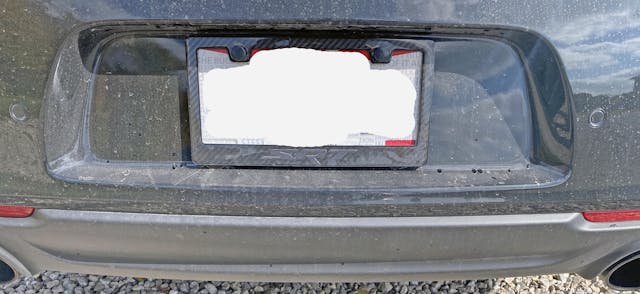
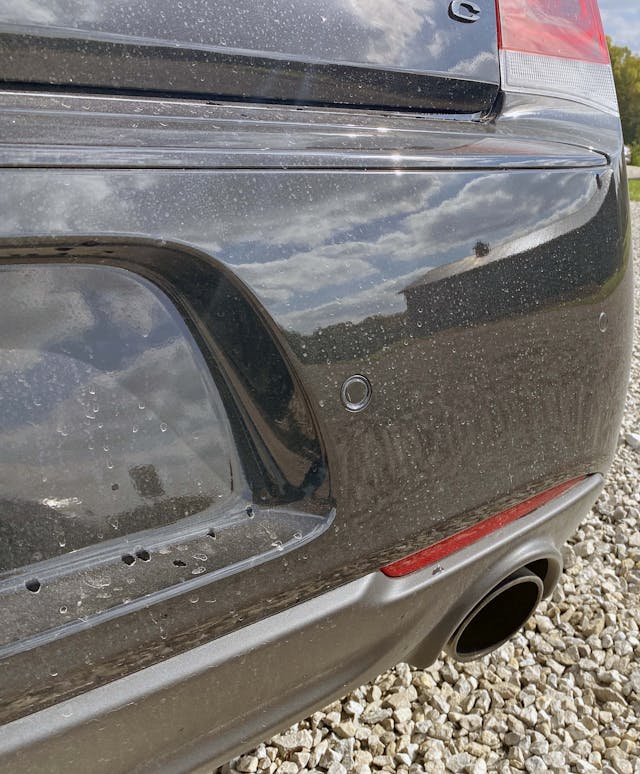
Just like the original, Chrysler opted to put the license plate mount in the rear bumper, leaving an acre of underutilized space in the trunk above. It’s a nice change to the usual “trunk plate” seen on today’s Camry and Accord, but it looks unfinished compared to the heckblende-equipped trunks of the Charger, Sonata, and (Kia) K5. I’d personally like to see C-H-R-Y-S-L-E-R spelled out on the back to fill in some space—and to be proud of this once-famous brand, and the founder behind it.
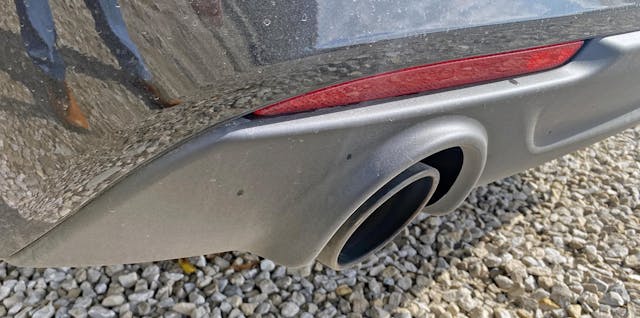
The lower bumper sports a matte plastic insert with arches around the exhaust, sized appropriately to match the wheel arches on the body side. The integration of the reflector lens into the insert’s outer boundary with the painted bumper is a common trick for modern cars, one that is both clever and beautiful.
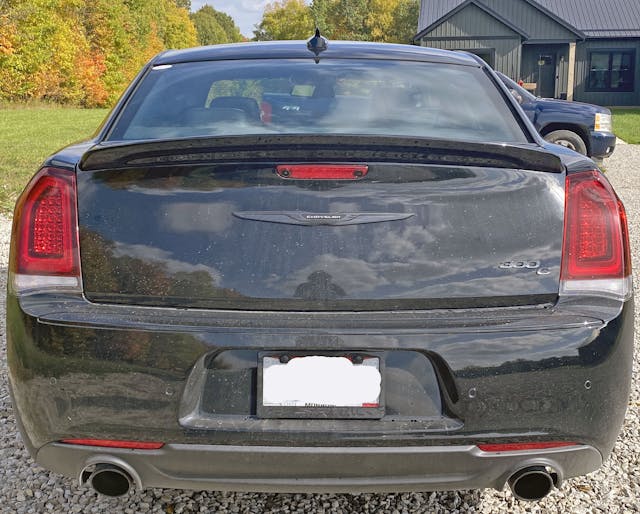
The ducktail spoiler is a wonderful touch, adding much-needed visual excitement to the 300’s tall and flat-faced posterior. But it’s all relative, because this butt clearly received hundreds of hours more surfacing time from Chrysler designers than the same area of the 2005 original: The decklid is toned and muscular, and the 2022 bumper tries hard not to have a big-faced smile anymore.
It works, as the 300 now has a cocky smirk instead. Be it a Pentastar or 6.4-liter Hemi, anyone who has driven Chrysler 300 knows it’s pretty darn fast. Pick a fight with one and you know that trunk is absolutely giving you a victorious smirk, because it knows who won the race. While it’s a shame that family sedans are an unprofitable genre deemed unworthy for most automakers, at least the Chrysler 300 made a splash in 2005 and went out with a helluva bang last year.
Thank you for reading; I hope you have a lovely day.
***
Check out the Hagerty Media homepage so you don’t miss a single story, or better yet, bookmark it. To get our best stories delivered right to your inbox, subscribe to our newsletters.



You know I will not get overly critical here of this car. It is a car that the styling held up well considering how truly old it is.
Yes it is old. It is over weight and has had a series of quality issues. But is looked good. It was not over chomed and in tune with the times
This was a car that had to meet several decades on increased crash testing. Hence the weight and tall profile. The odd creases and body line were there to break up open areas but also to strengthen the panel surfaces width adding more weight. Also many small ones are there to channel air.
My Inlaws have one of these and it has been ok for the most. A shifter issues that keeps coming back and some other issues with gauges etc.
But what gets left out here is this was a luxury car that was often being sold for the price of a FWD Malibu. It was a total bargain with a standard V8 or a V6. I remember seeing these sold new for $28K at a time Cadillac and Lincoln was trying to pander FWD cars for $80k.
I just know when this goes so will the era of low priced RWD and I find that really sad. Only Cadillac will have anything reasonable.
How can you say the 300 is overweight? We are quickly entering the world of truly overweight electric vehicles. The new GMC Hummer EV weights 9000 lb, which is double the weight of this sedan. These things really move with the 6.4 Hemi. In the past, I thought they were overweight, but with the really heavy electrics coming out, people must not care too much about weight. The new Dodge Charger EV has a listed curb weight of 6000 lb, which is definitely overweight.
To me, the worst part of the 300C, visually, is the short deck. I seem to recall it has roots in the 300M being a “five-meter car” for world markets, in contrast with the Intrepid, Concorde, and LHS. The Charger is longer, which is perhaps why it is more longed for.
The 2nd generation of this car, as shown here, is better-looking to me when you see it on the road, but not nearly as memorable as the original. People will still talk about the 2006 300 long after they forget this one.
Another brilliant VV from the master, pulling no punches — but I feel compelled, in the car’s defense, to note that there is no “casting” involved in those wheels. On the 2023 392-powered car, they are FORGED.
The five meter car reference is apt and I wish I remembered that at the time of writing! I am certain the 300s trunk was stunted for that reason, be it for international Chrysler 300s or inadvertently for the Lancia Thema.
Forged wheels indeed! Thank you for the correction, I have amended the article.
Good article. Talks about styling etc. things I had not considered.
Wow those are expensive wheels. Forged alloy wheels are typically very light weight and costly! Yet the former at least is quite beneficial since of course the suspension will have far less wheel to control.
Does point out this car’s prestige. (hard to smuggle those wheels into a $15k car!)
In the motorcycle world forged wheels are a big deal. You don’t get them, except on the up-model machines costing thousands more.
Personally I prefer forged alloy wheels to carbon fiber wheels (especially on a motorcycle). Give me metal.
There’s a real talent displayed in their making the wheels look like ‘stock’ or cast wheels so they’re not huge magnets for theft. Well done. They really do look cast!
Had a leased 300S from 2017-2020. Liked the style and drove well. Did not like cheap bendable and easily scratched plastics on the door panels and other areas. Nearly drove the car into the garage wall as the dial shifter doesn’t have much for detents to feel you are in park. Could have bought the car out of lease cheap right as Covid started. Electronic gremlins were starting to surface just as the car’s 36K warranty and the lease was ending. It’s replacement–a well kept 2007 Lexus ES350–has twice the build quality. I bought it with 140K and it feels like it has 14K….
I hate the dial shifter. That is when it works. If it locks you have to pull the battery cable.
I am interested in a 300. Right now l have a 2012 with less than 30000 miles, what would be a good price for it? I am interested in a 300, just not a new one. I like the older style and l love the pearl color and beige interior with mid mileage and one owner. Thank much!
I swapped my 2004 Mercury Marauder for a new 2020 300S 5.7. Black on Black with the ‘Alloy Group’ appearance package. Most options included except for the Safe T Tech Plus package and Premium Group 2. Very pleased with the 300 overall. Unfortunately, Mopar still has issues with dealer support, like they did when I bought my last new Chrysler in 1985.
The 2023 300C? Love it. Sadly, some decontenting came into play with the rear armrest and trunk lighting – all that I know of. With the 2023 300S, the powered rear sunshade was deleted – sad.
Still, these cars have been underrated from the beginning and will be sorely missed. The built in Mercedes engineering is a plus and it shows, especially in the driving experience. Glad to have gotten mine when I did.
The performance to dollar ratio on the 300C is unmatched. Loaded and 485 horsepower for $56k? Sign me up!
I like it. I had fun with an older SRT8 version around 2010 that was a lot of fun. I am sad to see it go if for no other reason another RWD V8 car goes away. I did a Lexus IS 500 instead as I trust Lexus over Chrysler.
I also agree with the funky gear shifter, not my liking. No one has mentioned the “bland” interior. At least they could of done was make it two-tone leather for the seats and door panels. Remember the 2006 300 with the “Heritage” package? It had the circular red, white and blue 300 emblem on the seats and on the outside of the car, mid level with stainless molding. Maybe I should save 40k and find a mint Heritage edition for 10k.
Great piece. I really enjoyed your detailed (and biting) analysis. Always liked the Magnum SRT8 wagon version, but could never quite get over the well reported quality issues and the hard interior plastics. I bought a six-speed manual BMW X3 instead and it served my family very well for almost half of the two decades we lived on the snowy, frozen Prairies. Ugly in the way of all jacked-up SUV versions of wagons, but a great vehicle that handled better than a Dodge or Chrysler sedan in any case.
Thank you for reading. I wanted to like the Magnum, and the refreshed nose did help a little. The rear hatch was misleading if I recall, because it cut into the sloped roofline so you didn’t know how tall of a box you could stuff in there without having the sloping “roof” close onto it. Also that D-pillar was way too fast for a station wagon, but that’s a common issue for many hatchbacks these days. Nobody winces when implementing interference fits these days, I guess.
I see them in the junkyards now, and they do make me sad that they aren’t worth keeping. (At least the V6 models.)
Great article Sajeev!
The Magnum’s rear hatch is based on the Shooting Brake, and as such the hatch is designed so that the interior is protected from rain and snow when the hatch is open – a very practical feature for a rear hatch. Using a tape measure will allow you to determine in advance if your cargo will fit.
The D pillar’s slope adds to the Magnum’s cool looks. The Magnum was only built for 4 years, this contributes to the fact that you don’t see many on the road – a future classic for sure.
Many manufacturers copied the magnum, Toyota, Cadillac, etc. But no one came close to the Mag’s cool Hudson type looks.
I have no idea where you got your ideas about reliability issues, maybe they were specifically related to the SRT8 and its engine?
I have driven a 2006 Mangum SXT since new and she is still going strong, 230,000 Kilometers (143,000 miles) in a vey harsh climate (Eastern Ontario) that is also one of the worst places on earth for road salt and humidity.
My only issues are the front stabilizer bar bushings that keep keep going soft due to their proximity to the cats, a typical German engineering screw up where German engineers spend too much time dicking with stupid small things and don’t see the bigger picture. The other issue is the brake pads that wear out too quick – mostly due to the fact that in Drive there is no compression braking, just freewheeling. To solve the issue keep the tranny in 4th.
Because you settled for a BMW and (gulp) an SUV of all things, I think you completely missed the point of the Magnum.
The Magnum is an American Station Wagon (built in Canada though), intended to be Station Wagon 2.0, and at the same time it is also a sleeper muscle car with awesome handling due to a low centre of gravity and 50/50 weight distribution. And yes, the Magnum has a hard plastic interior, but it was never intended to be a luxury car, the suspension is way too stiff and it is intended for hauling all kinds things and 4 x 8 sheets of drywall.
I think that the shoulder line in the C pillar looks awfully like the inside of the same piece on the 68-70 Charger, and that isn’t a bad thing!
I drove one of these as a rental last year, same colour and everything. Really liked it, although the high window line makes it difficult for kids to see out (a very common problem tbh). Yes the gear selector was annoying, and the dials hint at electroluminescence, it was a great ride.
Love reading styling analyses such as this, especially on cars I care about–I had an AWD 2013 which was amazing in snow and ice: completely unperturbed tank. I could drive at the speed limit when everyone else was doing 25 mph or less.
I never drove an AWD model, but that makes sense. They drove fantastic on the highway with that Mercedes-derived suspension. Thanks for reading!
These have always looked to me like bricks with a squashed greenhouse; very unattractive. It was astonishing how much better the Dodge Charger of the same years looked. Also better-looking by far was the older “cab-forward” generation of the 300, and its Dodge and other Chrysler kin.
The last of the 300C. I work for a Chrysler dealership in sales. I waited for almost 10 months before it arrived. I have put it into my collection and to take to car shows. It will feel like an end of an era.
My father loved his Silver 2005 AWD Hemi 300. He rarely used it. He was more of a truck type of guy. I loved the fact that this car looked so different than most others on the road. I could tell Dad was on the way from a block away. So much of that car was unusual. When my father passed away a few years ago, me being the only car guy in the family, I ended up with the 300. When I took over the reins in 2021 there was only 5,000 miles on the odometer, and yes, it was functional. So it was quite the experience, when going back 17 years later, to the original dealership, to have their Service Dept bring up the 300’s history…which showed “none.” It was proud day for me, representing my Dad by taking his beloved 300 Hemi in for its first ever oil/filter change and inspection. Obviously, I requested all fluids be replaced due to time. It was cool when I was told by a young mechanic working there that word has spread about a 17 year old car, being serviced today for the very first time. I suppose just one of those little things that made their day a little more interesting. Today, my wife loves the car, especially during winter driving. It is a TANK and it’s hers now. It will never be sold. Still has the little factory “Genuine Leather” string tags hanging on the head rests. To my surprise, my dad never did upload the GPS-CD disk which I found in the glovebox. I guess when you’re in your late 80’s you know were you’ve been and where you’re going. Anyway, I still have the CD in the Chrysler sealed envelope, waiting in the glove box. I’m just not ready yet. Probably never will be.
Hey AC. Lovely touching comments about your dads 300. Car has a story. Never sell. Dave.
Australia
Great article! I used to work at the company that made the prototype 300C for Chrysler in 2002. Then I bought a new 2005 300C and had it a few years. Brings back great memories.
Glad you enjoyed it, as you certainly saw this vehicle from a unique perspective! Thanks for reading.